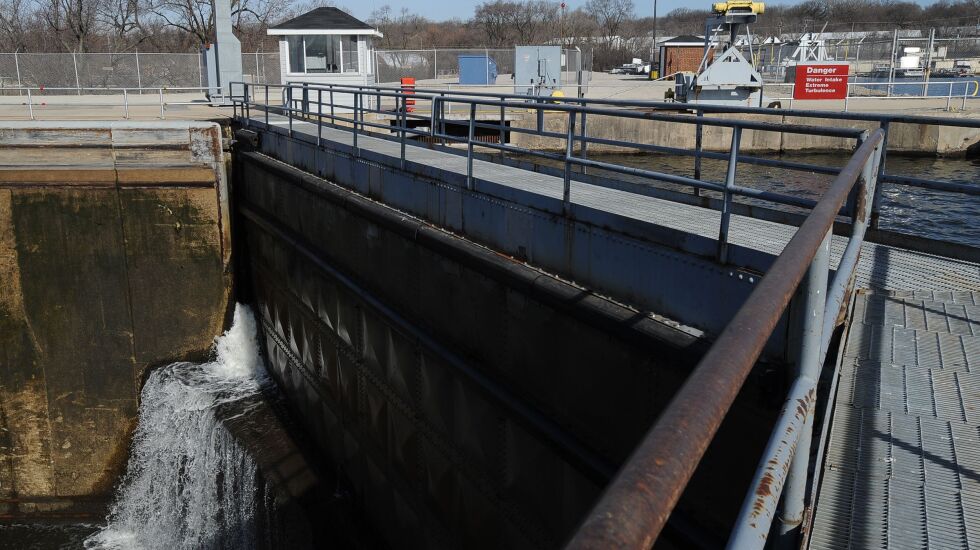
Two spent red 12-gauge shotgun shells, among other detritus, littered the point of the peninsula below the Brandon Road Lock and Dam on the Des Plaines River in Joliet.
“There was a tire swing in that tree,” Mark Cornish said pointing to an overhanging tree.
Cornish, biologist, senior technical specialist for the U.S. Army Corps of Engineers, led our group Wednesday on the tour of the area that will center the Brandon Road Interbasin Project.
The $1.146 billion project is “a complex, innovative ecosystem restoration project being constructed to prevent the movement of aquatic nuisance species from the Illinois Waterway into the Great Lakes watershed.” That primarily translates to trying to keep invasive carp from the Great Lakes.

Funding is primarily at the federal level with Michigan adding $64 million and Illinois $50 million.
The project is ready to begin, pending Illinois signing the Project Partnership Agreement with the Army Corps. Negotiations continue. There’s some question of who is responsible for issues during construction and of who owns part of the peninsula, in part because of Illinois’ arcane riparian laws.
“Try to be soon, but not this week,” said Loren Wobig, director of the office of water resources, Illinois Department of Natural Resources.
When the PPA is signed, it would start what is expected to be a 10-year construction project of “a big lab experiment.”
I’m drawn to incongruous urban wild areas. Take Montrose Harbor, a premier shore fishing spot of the Great Lakes that is within earshot of the swishing hum of Lake Shore Drive; or Palmisano Park, Chicago’s blueprint for a modern urban park built around a quarry with a notorious history.
The peninsula downstream of Brandon Road fits that mix.
“This is the land that is forgotten in the middle of the river,” Cornish said.
But nature perseveres. A belted kingfisher rattled as I opened my car door. Deer tracks showed in the muck of the tire-track path on the peninsula. Anglers had worn trails through brush down banks, especially by the massive eddy downstream of the lock. A couple weathered duck blinds stood in the Des Plaines.
Winter brown vegetation trapped the usual urban trash. One area held discarded tires and a busted piece of electronics, which looked like something from the 1980s.
“This is kind of a wasteland,” Cornish said.
It will evolve over the next 10 years and beyond. Will it stop silver and bighead carp from reaching Lake Michigan? It could be part of the solution.
First sign of that evolution are green monitoring wells, which measure water levels and help with chemical analysis.

Andy Leichty, project manager for the Army Corps, said basic water level is 505 feet above sea level below the lock and dam. The 100-year flood level is 510; the 500-year flood is 514. The plan is to have the buildings and the peninsula top at 517.3 feet.
The peninsula, made when the channel for the lock was dug, is basically a two-rut road. Leichty said it will be expanded to 40 feet wide for the buildings, an access drive and a small parking area.
Over the decades that Illinois has been at the forefront of stopping invasive carp from reaching Lake Michigan, technology evolved, including how to market invasive carp (“Copi”?). There’s advances in understanding eDNA (though I sometimes consider it “boy crying wolf”) and the uses of acoustic deterrents (already being used via barges when the current electric barriers at Romeoville are offline).
This project will bring other innovations. Wobig said industry people think they can break up and remove the bedrock without completely removing water. The flushing lock, which will take water from upstream and flush the lock, still needs to be fully designed.
Construction will include an engineered concrete channel with electric barrier, underwater acoustic deterrent, air bubble curtain and an automated barge clearing deterrent (basically blowing out fish hidden or trapped between or in barges).

Hopefully, innovations will extend to fish mitigation. If the project stops invasive species, it will also stop native species from natural movements. Physically moving native species around the project seems unlikely; maybe utilizing the Downstate Jake Wolf Memorial Fish Hatchery or learning a new method.
Walking out Wednesday, just past a bridge of unknown origins abandoned on the peninsula, we spotted what looked like a hornets’ nest.
It was time.
Time for the experiment to begin.
As Cornish put it Tuesday during the public open house, “We know more today than we did 20 years ago. We’ll know more 20 years from today.”
More on the Brandon Road Interbasin Project is at mvr.usace.army.mil/BRIP/.








